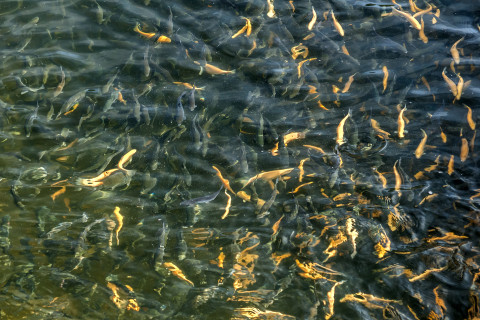Admixing genes of locally adapted wild fish with the hatchery fish might enhance stocking results by increasing the frequency of adaptive behavioural phenotypes, according to the doctoral dissertation of Nico Alioravainen, MSc.
Human activities have a major impact on river ecosystems worldwide. To compensate for the loss of natural habitats, massive stocking programs have been built to maintain fish stocks. The lack of natural reproduction and natural selection have led into another increasing threat to our fish stocks: domestication. Considering the ecological and socioeconomic value of brown trout as well as the other salmonid stocks, there is an urgent need for better fisheries management and research for fisheries-induced evolution, but also for study of behavioural conservation. Indeed, behaviour has been a long-neglected trait that can have direct effects on individual survival and fitness. While stocking programs have focused on numbers of stocked individuals, and maintenance of genetic diversity, the local adaptations and behavioural diversity have not been among main interests. This has led to unintended domestication and low stocking success making the expensive stocking programs ineffectual.
In his doctoral dissertation, Alioravainen focused on strain differences in behaviour and behavioural conservation in hatchery breeding programs. He studied how a brown trout strain, reared in the hatchery over multiple generations, differs in behavioural diversity from wild brown trout from the same original watershed. By controlled crossbreeding between these two strains, he aimed to rewild the local hatchery broodstock with wild resident fish. The results show that hatchery strain brown trout juveniles differ from wild strain fish in their acute post-release behavioural response and disperse rapidly downstream after release. Hatchery-strain fish show higher risk-taking and exploration behaviour than wild crosses, which will likely increase their mortality in the wild. The relative vulnerability to angling may cause diverged within-strain phenotypic behavioural effects in hatchery and wild strain fish. Results with wild strain fish supported the prediction that by selectively increasing mortality on bold fish, fishing results in increased timidity in fished populations.
Admixing genes of locally adapted wild fish with regional hatchery fish could enhance stocking results by increasing the frequency of adaptive behavioural phenotypes. A rewilding project may not only save the last remaining lake-run brown trout in Oulujoki watershed but also provide an example of how hybridization may conserve the evolvability of the population. Even though the crossbred fish may offer options to rebuild brown trout populations in restored small streams, efficient environmental and fisheries management is needed to conserve the original iconic adfluvial brown trout stocks.
The doctoral dissertation of MSc Nico Alioravainen, entitled Behavioural conservation in hatchery-reared brown trout - phenotypic effects of controlled crossbreeding with wild fish will be examined at the Faculty of Science and Forestry on the 13th of November, 2020. The public examination will be streamed online. The opponent in the public examination will be Professor John Piccolo, Karlstadt University, Sweden, and the custos will be Professor Anssi Vainikka, University of Eastern Finland. The public examination will be held in English.



